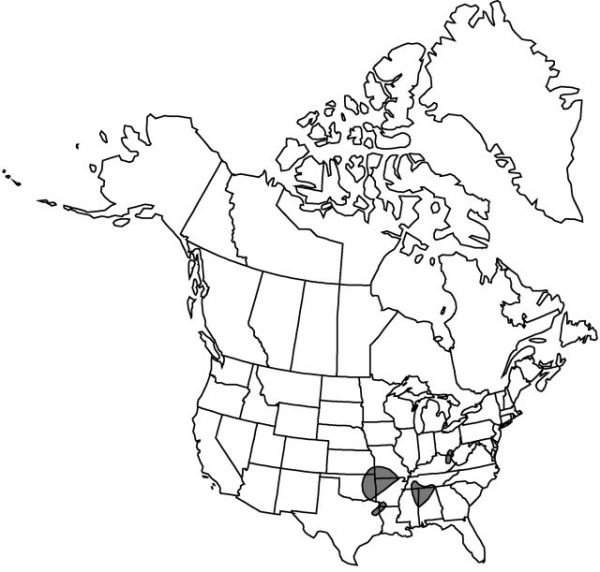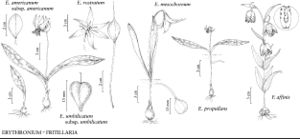Difference between revisions of "Erythronium rostratum"
Castanea 6: 24, plate 1. 1941.
FNA>Volume Importer |
imported>Volume Importer |
||
| (6 intermediate revisions by 2 users not shown) | |||
| Line 8: | Line 8: | ||
}} | }} | ||
|common_names=Beaked trout-lily | |common_names=Beaked trout-lily | ||
| + | |special_status={{Treatment/ID/Special_status | ||
| + | |code=F | ||
| + | |label=Illustrated | ||
| + | }}{{Treatment/ID/Special_status | ||
| + | |code=E | ||
| + | |label=Endemic | ||
| + | }} | ||
|basionyms= | |basionyms= | ||
|synonyms= | |synonyms= | ||
| Line 24: | Line 31: | ||
|elevation=0–500 m | |elevation=0–500 m | ||
|distribution=Ala.;Ark.;Kans.;Ky.;La.;Miss.;Mo.;Ohio;Okla.;Tenn.;Tex. | |distribution=Ala.;Ark.;Kans.;Ky.;La.;Miss.;Mo.;Ohio;Okla.;Tenn.;Tex. | ||
| − | |discussion=<p>Erythronium rostratum is found mostly on either side of the Mississippi River embayment, but rarely within it. It often forms extensive colonies where nonflowering, 1-leaved plants far outnumber flowering ones. This is the only species of Erythronium with erect rather than nodding flowers. Some plants at the western limits of the range are triploids (B. L. Carr 1986).</p> | + | |discussion=<p><i>Erythronium rostratum</i> is found mostly on either side of the Mississippi River embayment, but rarely within it. It often forms extensive colonies where nonflowering, 1-leaved plants far outnumber flowering ones. This is the only species of <i>Erythronium</i> with erect rather than nodding flowers. Some plants at the western limits of the range are triploids (B. L. Carr 1986).</p> |
|tables= | |tables= | ||
|references= | |references= | ||
| Line 33: | Line 40: | ||
-->{{#Taxon: | -->{{#Taxon: | ||
name=Erythronium rostratum | name=Erythronium rostratum | ||
| − | |||
|authority=W. Wolf | |authority=W. Wolf | ||
|rank=species | |rank=species | ||
| Line 47: | Line 53: | ||
|publication title=Castanea | |publication title=Castanea | ||
|publication year=1941 | |publication year=1941 | ||
| − | |special status= | + | |special status=Illustrated;Endemic |
| − | |source xml=https:// | + | |source xml=https://bitbucket.org/aafc-mbb/fna-data-curation/src/2e0870ddd59836b60bcf96646a41e87ea5a5943a/coarse_grained_fna_xml/V26/V26_271.xml |
|genus=Erythronium | |genus=Erythronium | ||
|species=Erythronium rostratum | |species=Erythronium rostratum | ||
Latest revision as of 21:14, 5 November 2020
Bulbs ovoid, 10–20 mm; stolons 1–3, common, mostly on 1-leaved, nonflowering plants. Leaves 5–18 cm; blade green, irregularly mottled, elliptic-lanceolate to ovate or elliptic, ± flat, not glaucous, margins entire. Scape 3–10 cm. Inflorescences 1-flowered. Flowers held erect at anthesis; tepals yellow, tinged red-purple or orange abaxially, mostly spreading at anthesis, lanceolate, 20–34 mm, inner with conspicuous, well-developed auricles almost encircling opposing filaments; stamens 13–17 mm; filaments yellow, lanceolate; anthers yellow; pollen yellow; style persistent, greenish yellow, swollen distally into stigma, tapering gradually proximally to ovary, forming beak on capsule, 8–11 mm; stigma lobes erect, short, 1 mm. Capsules held erect at maturity on upward-curving peduncle, ellipsoid to ellipsoid-obovoid, 15–25 mm (excluding beak), apex long-beaked. 2n = 24.
Phenology: Flowering spring.
Habitat: Mesic woods, often in flood plains and along waterways, also on shaded lower ledges of bluffs
Elevation: 0–500 m
Distribution

Ala., Ark., Kans., Ky., La., Miss., Mo., Ohio, Okla., Tenn., Tex.
Discussion
Erythronium rostratum is found mostly on either side of the Mississippi River embayment, but rarely within it. It often forms extensive colonies where nonflowering, 1-leaved plants far outnumber flowering ones. This is the only species of Erythronium with erect rather than nodding flowers. Some plants at the western limits of the range are triploids (B. L. Carr 1986).
Selected References
None.
